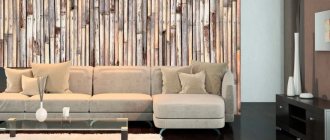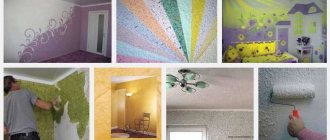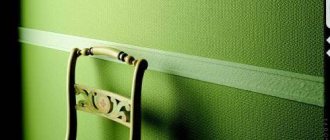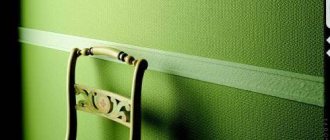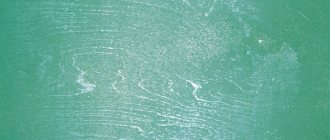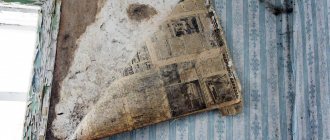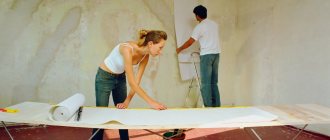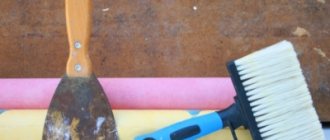Peculiarities
Non-woven wallpaper is extremely popular these days. They got their name due to the material from which the bottom layer of the coating is made.
Non-woven fabric appeared quite recently and was initially used in the production of fabrics. But after a while it firmly took its place in the production of finishing materials.
Kinds
Today, manufacturers offer two main types of products: wallpaper with a non-woven base and completely non-woven wallpaper. The first option has two layers, the top of which consists of vinyl, textile or paper components.
At first glance, good non-woven wallpaper looks like paper, but to the touch the material is no different from fabric.
A textile covering is considered the safest and, due to its density, can mask any unevenness and stains on the wall.
There are three types of vinyl covering: smooth, foamed and embossed. Such wallpaper is resistant to mechanical damage, durable and very easy to care for.
Products with a paper top layer are safe for health, have a low cost and are suitable for a bedroom or “children’s room”. The presence of several layers of this wallpaper makes it easy to achieve a beautiful relief pattern.
Fully non-woven wallpapers are superior to their counterparts in durability; they have several smooth layers, the top of which may have a textured coating.
This type of finishing materials for walls is usually used for painting. Moreover, non-woven wallpaper can be painted repeatedly, which is very convenient and simplifies a radical change in the design of the room.
Note!
- Wallpaper glue - 155 photos of the best compositions. Review of manufacturers and the best glue brands
Wallpaper from Leroy Merlin: 180 photo examples and video master class on the use of different types of wallpaper
Wallpaper for the kitchen - types, types, designs and expert advice on choosing a design (165 photos + video)
Recommendations for wallpaper care
Wallpaper made from non-woven fabric does not require complicated maintenance. But when cleaning walls, it is necessary to take into account the characteristics of the coating so as not to spoil it with detergents.
Regular care consists of regularly cleaning surfaces using a dry cloth, napkin or vacuum cleaner with a special attachment. Products coated with a waterproof composition can be wiped with a damp sponge using a cleaning agent specially made for non-woven wallpaper. It is strictly forbidden to clean surfaces with hard brushes, powders or other abrasives.
Fingerprints are erased with a regular eraser. Serious stains are removed using a paper napkin, which is applied to the desired area and ironed. Regular stains can be removed with a sponge.
Non-woven wallpaper, which has many advantages, is a favorite material of designers for decorating stylish interiors. The products are expensive, but they last quite a long time. If there is a need to change the appearance of the interior, the wallpaper can be refreshed by painting it in a new color.
Advantages and disadvantages
Non-woven wallpaper has a number of significant advantages:
- Resistance to deformation. After gluing to the wall, they dry and acquire their original appearance.
- The embossed top layer allows you to hide defects on the walls. Suitable for gluing to wood, plaster, putty, drywall.
- The surface of the wallpaper can be washed.
- Wide rolls. Thanks to this, wallpapering is significantly faster, and there are much fewer joints. They are not susceptible to fading in the sun.
- They have a long service life.
Non-woven wallpaper, in addition to all its positive properties, also has disadvantages:
- Coverings with a relief pattern easily become damaged and scratched. You should not choose such wallpaper for a child’s room or if you have pets in the apartment.
- Dirt can accumulate behind the textured design, which will cause inconvenience during the cleaning process.
- Wallpaper with a top layer of polyvinyl chloride is not considered environmentally friendly.
- Non-woven wallpaper is quite expensive.
Properties of non-woven fabric
Undyed non-woven interlining is a non-woven paper-like material of a yellowish or white color. Due to chemical cross-linking and modification of fibers during the formation of the material, interlining has tensile strength, fire resistance and abrasion resistance. Depending on the chemical modifications of the fibers that form the interlining matrix, it can be non-wettable, water-wettable or water-soluble. Water-insoluble non-woven fabric does not lose shape when in contact with water and does not shrink when dried. The material almost does not wrinkle and easily tolerates non-aqueous paints, this allows you to obtain non-woven fabric of all colors.
How to glue
After applying the glue to the wall, the strip of wallpaper is pressed against the wall and smoothed to remove excess glue. The wallpaper is trimmed at the top and bottom, taking into account the width of the baseboards.
Note!
Types of wallpaper: features, pros and cons of wallpaper types. Classification by texture, number of layers, drawing (photo + video)
Wallpaper for the apartment - TOP-150 photos and videos of wallpaper design options for the apartment. Variety of materials, textures, colors and wallpaper patterns
Wallpaper for the bedroom: TOP 140 photos and video reviews of bedroom designs with wallpaper. Suitable styles, colors and patterns of wallpaper for the bedroom, choice of materials
Subsequent strips are glued in the same way, only now taking into account the matching pattern at the joints.
Colors and designs
Looking at the photo of non-woven wallpaper in the interior, one cannot help but be amazed at the variety of patterns and colors offered.
Large design elements, such as roses and monograms, are suitable for oriental-style rooms. Wallpaper imitating brick or stone will emphasize the originality of the apartment's interior.
A part of the wall covered with striped wallpaper will harmoniously combine with the plain background of the other walls; and lovers of bright details will be pleased with the wallpaper options with photo printing.
Minuses
There are also disadvantages to non-woven wallpaper. After pasting the smell remains. Which can last for more than a month. But by airing this drawback can be quickly eliminated.
You need to buy only high-quality wallpaper. The disadvantages include the high cost. It's much cheaper to buy paper ones.
How to choose
Beautiful and durable non-woven wallpaper is very popular in the finishing materials market. Any designer's ideas can be easily realized using the variety of shades and patterns of this wallpaper.
When choosing a canvas, you need to consider what room it is intended for.
Design ideas for room interiors
With proper organization of space, using color schemes for walls and ceilings, you can turn even the smallest room into a cozy home, be it a living room, kitchen, bedroom, nursery, bathroom or hallway.
Kitchen
It is usually not recommended to glue wallpaper in a room with high humidity, but in the case of non-woven wallpaper, many design experts definitely say “yes”.
Such fabrics are resistant to wear and moisture, they can be easily washed with delicate detergents.
What to look for when purchasing
When purchasing, you should pay attention to the following factors:
| 1 | Material of manufacture | The material of manufacture affects both the use of wallpaper and the location. Vinyl ones are perfect for places with heavy mechanical load; the rest are better placed in places where there will be less load and contact. |
| 2 | Glue requirements | Requirements for glue are sometimes indicated on the packaging. It is not necessary to purchase it from the exact brand recommended by the manufacturer - in fact, they rarely differ in special properties and most often are a common overpayment for the brand. |
| 3 | Roll width | Width affects ease of use. A narrow one is more convenient in rooms with a large number of corners and narrow elements - radiators and pipes. Wide is more suitable for large rooms with straight walls. |
| 4 | Quality | It is also worth paying attention to quality. Since non-woven wallpaper has a multi-layer structure, the edges should not “delaminate”. It is also necessary to check whether all rolls belong to the same batch. This is extremely important for dark canvases - the shade may differ between different batches, which will be extremely noticeable |

